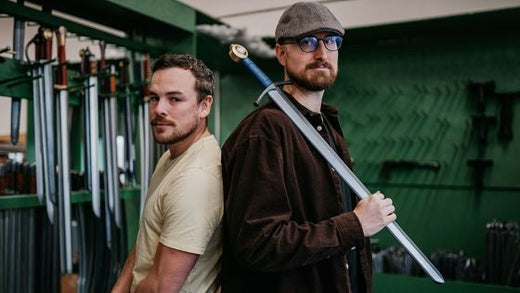LARP blaster
We are proud to present a whole new world of LARP weapons - safe and authentic looking firearms!
Made entirely out of steel and wood, this blasters is sure to bring any armored knight, musketeer, or pirate costume to perfection!
Use
Hello fellow larpers. I am Red from Fakesteel and today, I’ll show you how to use and take care of our larp muzzleloading blasters.
Our blasters are primed by compressing a plunger assembly inside the barrel. You do this by inserting the priming tool into the muzzle and pressing it until it engages the catch mechanism. The easiest way to prime the gun is to put its butt against your thigh with the lock pointing away from you, and pressing the loading tool with your dominant hand. When it reaches engagement, you will hear an audible click.If you find this hard to do, you can also prime the gun against a solid surface like a table, using your body weight. Make sure to always hold your gun while doing that style of loading to avoid it slipping.
Afterwards load either the ball…. Or the dart… into the muzzle.
When loading the ball, you can push it as far as it will go with your finger, the muzzle choke will prevent you from putting it too far. Do not use the loading tool to ram the ball down. It doesn’t go far, and you would only damage the ball.
If you load the ball in a pistol that is not primed, you can remove it with pointy pliers.
When loading the dart, only insert it until the tip gets to the level of the muzzle. There’s nothing preventing you from pushing the dart all the way into the piston, and if you accidentally do that, it will be really hard to remove.
If you want, you can add a bit of talc or baby powder after loading the gun to create a smoke effect. Make sure you have a ball loaded, as the powder will build up and potentially clog your gun, if you pour it directly into the mechanism.
The gun is now ready to shoot.
You can carry it safely while loaded, however, keeping it primed for long periods of time introduces unnecessary stress on the mechanism. It’s therefore advisable to shoot it at the end of any event you’re using it for and it’s also good to empty it every evening of the event too. It is possible for the gun to shoot accidentally, if dropped on a hard surface, or if you accidentally pull on the trigger. However, due to the very safe projectile, an accidental discharge is not dangerous.
Do not dry fire the gun, unless it’s necessary.
While the guns are relatively hardy, don’t expose them to needless stress, like dropping them on the ground or using them to stabilize a table. Also don’t use them to parry blows. The lock might tear out, if there’s unreasonable leverage on it and it’s very likely to damage any larp weapon it gets hit with.
Maintenance
The most important part of the maintenance of our guns is keeping them well oiled and lubricated. This prevents rust and ensures that the mechanism operates smoothly. You can use any kind of anti-corrosive technical oil, the seal in the piston is leather, which doesn’t degrade in oil, like rubber does. I personally use Silkal, which is silicone based.
To oil the lock, simply spray it and use a rag to wipe excess oil. You can also wax the lock to make it more rust resistant, but I find that oil works sufficiently well. If you get any rust spots, you should be able to easily clean them with an abrasive sponge.
To lubricate the barrel, put the gun against a table, spray a generous amount into the muzzle and “pump” the piston a couple of times with your ramrod to almost engagement so that you spread the lubricant on the inside of the barrel. After that, engage the mechanism, pour out as much of the oil as possible, load a ball in and fire the gun. It’s good to lubricate the barrel before and after any event you were using the pistol for.
Sometimes you should also oil the trigger mechanism by simply spraying a lot of oil into the trigger hole and pouring out any excess.
On some very rare occasions, the glue holding the barrel might give, especially with non-ideal loading techniques and the barrel can fall out of the stock. This can be solved easily by pouring a bit of Polyurethane glue in the stock and putting the barrel back in, securing it with a strip of tape until the glue hardens. Make sure to put the barrel as far back as possible. Don’t use too much glue and don’t put any in the last third of the barrel slot, as polyurethane glue foams up and rises and you don’t want it getting into the trigger mechanism. After it hardens overnight, cut off any excess glue and your gun is ready to shoot again.
Once the barrel stops working, it can be replaced relatively easily, either by us, or you can do it yourself with basic tools. This replacement will be considerably cheaper than getting a whole new gun.
When that situation comes, don’t hesitate to contact us, so we can figure out a solution.
Thank you for watching and I hope you always hit your mark!



